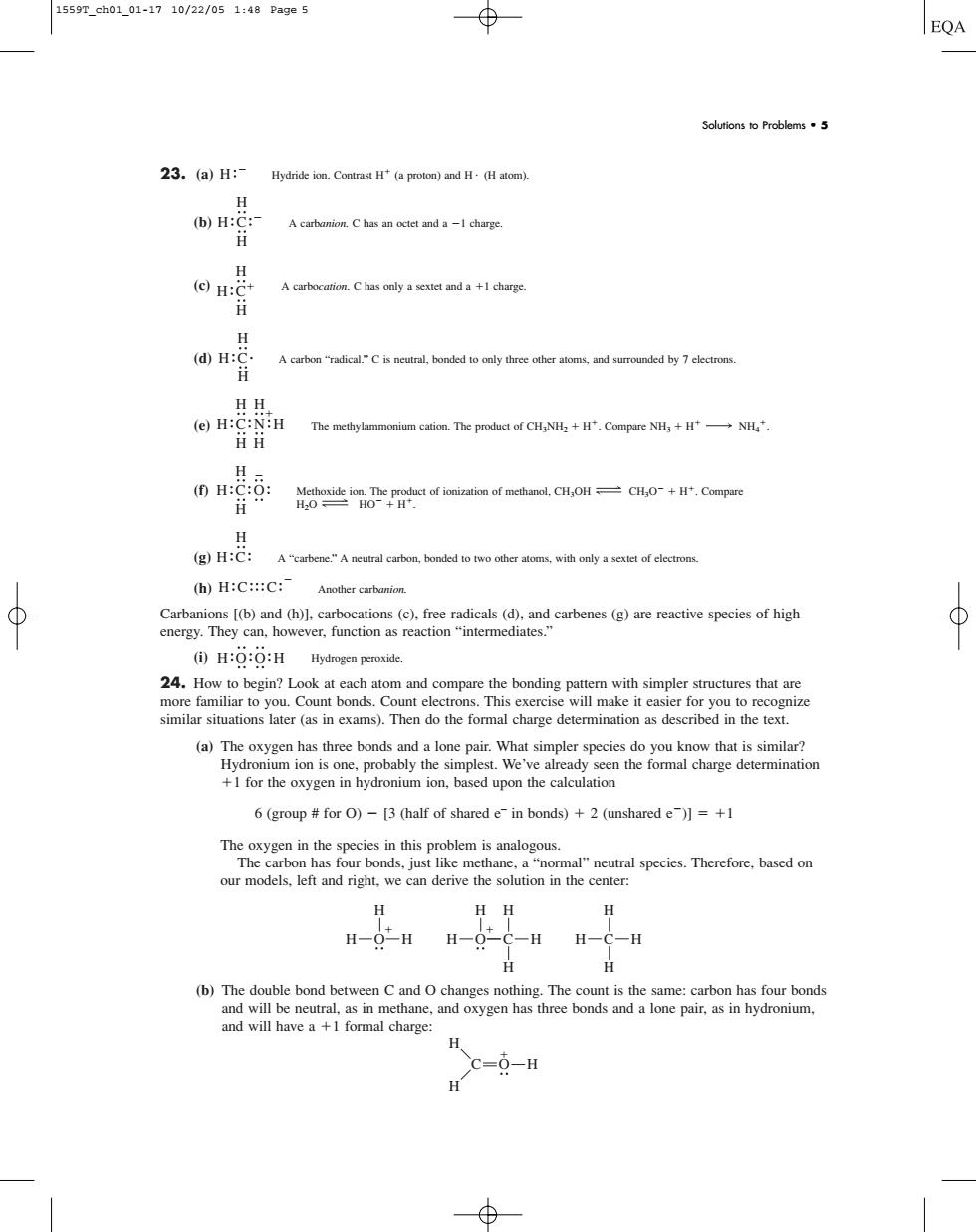正在加载图片...

1559T_ch01_01-1710/22/051:48Page5 ⊕ EQA Solutions to Problems.5 23.(a)H: Hydride ion.Contrast H(a proton)an HH) H (b)H:C:- A.C has an octet and a -l charge H A carbocation.C has only a sextet and a +l chargs H (d)H:C A carbon"radical."C is neutral.bonded to only three other atoms.and surrounded by 7 electrons :H The methylammonium cion.The product of CH,NH,HNH H (h)H:C:::C:- Another carbanion od) (H:0:O:H Hydrogen peroxide 24.How to begin?Look at each atom and compare the bonding pattem with simpler structures that are more familiar to you.Count bonds.Count electrons.This exercise will make it easier for you to recognize similar situations later (as in exams).Then do the formal charge determination as described in the text. (a)The oxygen has three bonds and a lone pair.What simpler species do you know that is similar? 6(group for O)-[3 (half of shared e in bonds)+(unshared e)]=+1 rmal"neutral species.Therefore,based on our models,left and rightwe can derive the solution n the center H (b)The double bond betv en C and o cha hing The the and will have a +1 formal charge: c=0-H 23. (a) Hydride ion. Contrast H (a proton) and HT (H atom). (b) A carbanion. C has an octet and a 1 charge. (c) A carbocation. C has only a sextet and a 1 charge. (d) A carbon “radical.” C is neutral, bonded to only three other atoms, and surrounded by 7 electrons. (e) The methylammonium cation. The product of CH3NH2 H. Compare NH3 H NH4 . (f) Methoxide ion. The product of ionization of methanol, CH3OH CH3O H. Compare H2O HO H. (g) A “carbene.” A neutral carbon, bonded to two other atoms, with only a sextet of electrons. (h) Another carbanion. Carbanions [(b) and (h)], carbocations (c), free radicals (d), and carbenes (g) are reactive species of high energy. They can, however, function as reaction “intermediates.” (i) Hydrogen peroxide. 24. How to begin? Look at each atom and compare the bonding pattern with simpler structures that are more familiar to you. Count bonds. Count electrons. This exercise will make it easier for you to recognize similar situations later (as in exams). Then do the formal charge determination as described in the text. (a) The oxygen has three bonds and a lone pair. What simpler species do you know that is similar? Hydronium ion is one, probably the simplest. We’ve already seen the formal charge determination 1 for the oxygen in hydronium ion, based upon the calculation 6 (group # for O) [3 (half of shared e– in bonds) 2 (unshared e)] 1 The oxygen in the species in this problem is analogous. The carbon has four bonds, just like methane, a “normal” neutral species. Therefore, based on our models, left and right, we can derive the solution in the center: (b) The double bond between C and O changes nothing. The count is the same: carbon has four bonds and will be neutral, as in methane, and oxygen has three bonds and a lone pair, as in hydronium, and will have a 1 formal charge: C O H H H H H H O H H C O H H H H H H C H H H O O H C C H H C H H C O H H H H C N H H H H H C H H H C H H H C H H Solutions to Problems • 5 1559T_ch01_01-17 10/22/05 1:48 Page 5���������